Traveling to Japan can seem daunting, but it’s an incredibly rewarding experience. This guide, brought to you by TRAVELS.EDU.VN, will equip you with essential knowledge for a smooth and enjoyable trip. From navigating etiquette to understanding transportation, we’ll cover everything you need to know about planning your Japan adventure. Let’s get started planning your journey to the Land of the Rising Sun, making your trip unforgettable!
1. Planning and Booking in Advance
Japan’s popularity as a tourist destination means that accommodation and transportation can get booked up quickly, especially during peak seasons. Securing your arrangements well in advance is crucial for a stress-free experience.
- Peak Seasons: Be aware of busy travel periods like the first week of January (New Year), cherry blossom season (late March-April), Golden Week (April 29-May 5), and August (Obon Festival). Booking months ahead is advisable during these times.
- Accommodation Options: From modern hotels to traditional ryokan, Japan offers a diverse range of lodging options. Ryokan often have specific check-in times, so coordinate your arrival to avoid any inconvenience.
- Advance Bookings: Reserve flights, hotels, and even popular restaurants well in advance, especially if you’re traveling during peak season.
1.1 Securing Your Ideal Accommodation
Booking accommodations in advance is not merely a suggestion; it’s a necessity, especially during peak travel periods. The most sought-after hotels and traditional ryokan (Japanese inns) can be fully booked weeks, if not months, ahead of time.
1.1.1 Avoiding Disappointment
Imagine arriving in a bustling city only to discover that your preferred hotel is fully booked. Booking ahead ensures that you secure the accommodation that best suits your needs and preferences.
1.1.2 Coordinating Arrival Times
Smaller inns or ryokan often operate with fixed check-in times. Arriving outside of these hours may mean that staff won’t be available, and your room won’t be ready. Confirming your arrival time ensures a smooth and welcoming check-in experience.
1.2 Strategic Timing for Budget Travelers
- Off-Season Travel: Consider visiting Japan during the shoulder seasons (spring and autumn) to avoid crowds and potentially find better deals on flights and accommodations.
1.3 Travel Seasons in Japan
| Season | Months | Highlights | Booking Advice |
|---|---|---|---|
| Spring (桜) | March – May | Cherry blossoms, pleasant weather, outdoor festivals | Book accommodations and transportation at least 3-6 months in advance. |
| Summer (夏) | June – August | Festivals, fireworks, hiking in the Japanese Alps | Expect high humidity; book accommodations and activities well in advance. |
| Autumn (秋) | September-November | Colorful foliage, comfortable temperatures, harvest festivals | A popular time to visit; book 2-4 months ahead. |
| Winter (冬) | December -February | Skiing, snow festivals, onsen (hot springs) | Book ski resorts and onsen towns early, especially during the holiday season. |
2. Packing Smart and Light
Space is a premium in Japan, especially in urban areas. Packing light will make your travels much more comfortable.
- Small Hotel Rooms: Hotel rooms tend to be compact, leaving little room for large suitcases.
- Public Transportation: Navigating Japan’s efficient but often crowded public transportation system is easier with less luggage.
- Dress Code: While religious sites generally don’t have strict dress codes, some upscale establishments may require smart casual attire. Consider versatile clothing that can be dressed up or down.
- Sitting on the Floor: Be prepared for dining experiences where you might sit on the floor. Comfortable clothing that allows for ease of movement is recommended.
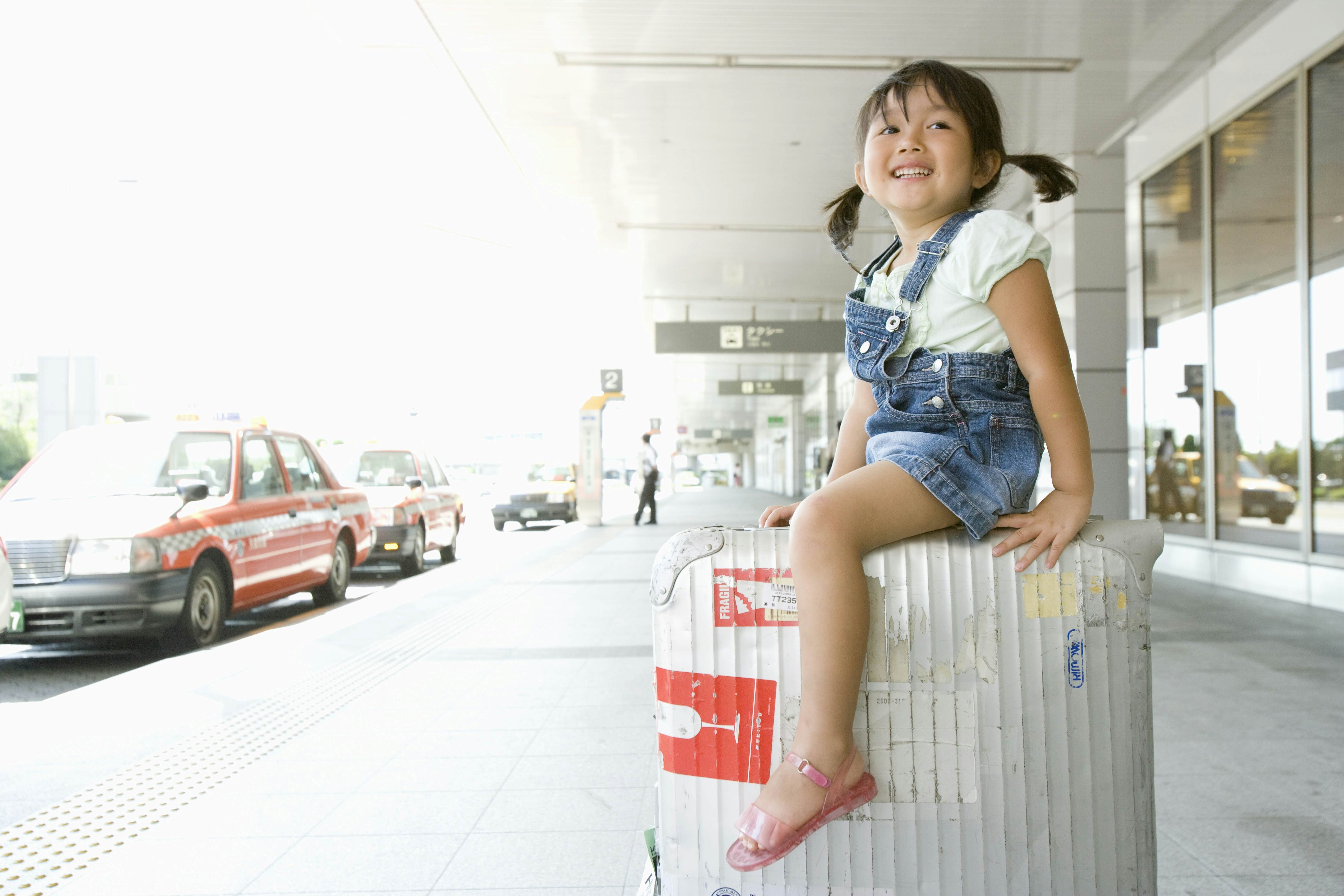 Girl with a suitcase outside an airport in Japan, indicating the importance of packing light
Girl with a suitcase outside an airport in Japan, indicating the importance of packing light
2.1 Essential Items
- Comfortable Walking Shoes: A must for exploring cities and temples.
- Slip-on Shoes: Convenient for removing shoes at temples, traditional inns, and some restaurants.
- Socks: Many visitors prefer wearing socks when using communal slippers.
- Adapters and Converters: Japan uses Type A and B plugs at 100V, so bring the necessary adapters and converters for your electronics.
2.2 Climate-Specific Packing
- Summer: Lightweight, breathable clothing; sunscreen; a hat; and a folding umbrella for both sun and rain.
- Winter: Warm layers, including a coat, gloves, and a scarf.
- Rainy Season (June-July): Waterproof jacket, umbrella, and quick-drying shoes.
2.3 The Art of Minimalist Packing
| Item | Quantity | Benefits |
|---|---|---|
| Universal Adapter | 1 | Ensures your devices stay charged across various outlets. |
| Versatile Clothing | 5-7 items | Maximizes outfit combinations, reducing overall baggage weight. |
| Compact Toiletries | Travel-sized | Complies with airline restrictions and saves valuable space in your luggage. |
3. Staying Connected with a Data-Heavy SIM Card
Navigating Japan’s complex address system can be challenging. A reliable data connection is invaluable for accessing maps, translation apps, and other essential travel tools.
- Address System: Japan’s address system can be difficult to navigate, even for locals.
- Navigation Apps: Smartphones with navigation apps are essential for finding your way around.
- Data Usage: Expect to use a significant amount of data for navigation, translation, and communication.
- SIM Card at the Airport: Purchase a data-heavy SIM card upon arrival at the airport for instant connectivity. TRAVELS.EDU.VN recommends this to all our clients.
3.1 Choosing the Right SIM Card
- Data Allowance: Opt for a SIM card with a generous data allowance to avoid running out during your trip.
- Validity Period: Check the SIM card’s validity period to ensure it covers the duration of your stay.
- Coverage: Ensure the SIM card provides reliable coverage throughout the areas you plan to visit.
3.2 Alternative Connectivity Options
- Pocket Wi-Fi: A portable Wi-Fi device can be a convenient option, especially for groups or families.
- Free Wi-Fi Hotspots: While free Wi-Fi is available in some areas, it may not be reliable or secure.
3.3 Navigating Japan’s Digital Landscape
| Service | Function | Why It’s Useful |
|---|---|---|
| Google Maps | Navigation | Essential for navigating Japan’s complex address system. |
| Google Translate | Language Translation | Helps bridge communication gaps in non-English speaking areas. |
| HyperDia | Train Timetables | Provides accurate train schedules, platform information, and route planning. |
4. Navigating Footwear Customs
Japan has unique customs regarding footwear. Being aware of these customs will help you avoid cultural faux pas.
- Removing Shoes: You’ll often be required to remove your shoes at religious sites, traditional inns, and some restaurants.
- Communal Slippers: Slippers are typically provided for indoor use in these establishments.
- Socks: Wearing socks is recommended when using communal slippers.
- Shoe Storage: Leave shoes in the designated area, such as a genkan (entrance area).
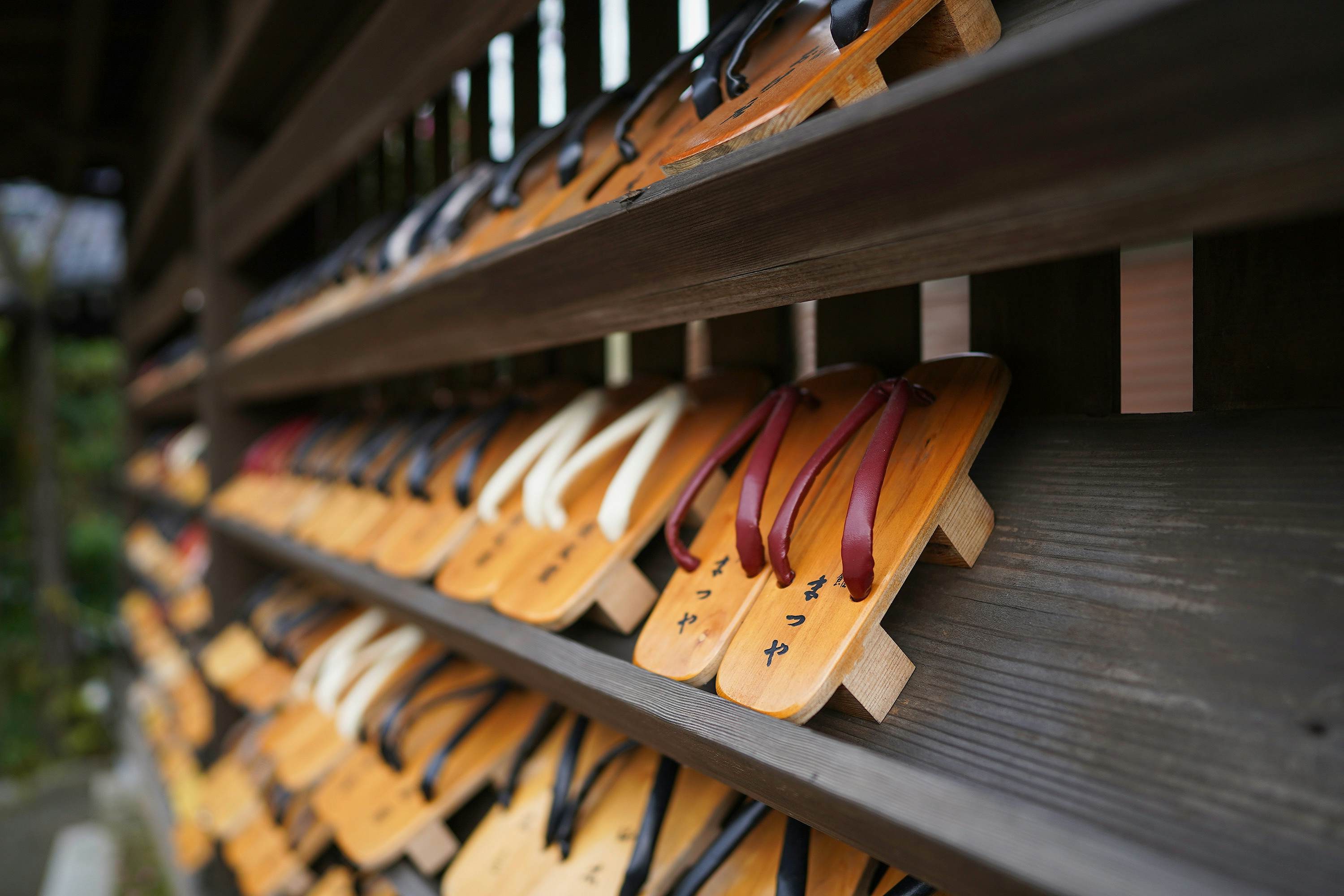 Japanese traditional geta sandals at Kinosaki Onsen, symbolizing the custom of removing shoes indoors
Japanese traditional geta sandals at Kinosaki Onsen, symbolizing the custom of removing shoes indoors
4.1 Understanding the Genkan
- Stepping Up: The genkan is a recessed entrance area where you remove your shoes before stepping onto the raised floor.
- Slippers: Slippers are typically provided for you to wear inside the building.
- Arranging Shoes: Turn your shoes to face outwards, making it easier to slip them on when you leave.
4.2 Dedicated Toilet Slippers
- Switching Slippers: In some homes and traditional establishments, you’ll find a separate pair of slippers specifically for use in the toilet.
- Returning Slippers: Remember to switch back to your regular slippers when leaving the toilet.
4.3 Footwear Etiquette Essentials
| Situation | Footwear Action | Rationale |
|---|---|---|
| Entering a Home | Remove shoes at the genkan; wear slippers provided. | Maintains cleanliness and symbolizes respect for the host. |
| Visiting a Temple | Remove shoes before entering the main worship area. | Shows reverence and respect for the sacred space. |
| Using the Toilet | Switch to dedicated toilet slippers before entering. | Prevents contamination and ensures hygiene. |
5. Mastering the Washlet: Japan’s High-Tech Toilets
Japan is renowned for its innovative technology, and its toilets are no exception. The “washlet,” a high-tech bidet toilet, offers a unique and hygienic experience.
- Wash and Dry: With the touch of a button, washlets will wash and dry your delicate parts.
- Pictograms: The buttons are clearly labeled with pictograms, making them easy to understand even if you don’t speak Japanese.
- Sound Machines: Motion-sensor-activated sound machines are designed to provide privacy.
- Hand Towels: Be aware that towels and hand dryers are not always available, so consider carrying a small cloth with you.
5.1 Decoding the Washlet Controls
- Bidet: For washing the rear area.
- Feminine Wash: For washing the front area.
- Dry: For drying after washing.
- Pressure: Adjusts the water pressure.
- Position: Adjusts the position of the water nozzle.
5.2 Common Toilet Customs
- Toilet Slippers: As mentioned earlier, dedicated toilet slippers are often provided in homes and traditional establishments.
- Cleanliness: Japanese toilets are typically very clean and well-maintained.
- Paper Disposal: Dispose of toilet paper in the toilet bowl, as it is designed to dissolve easily.
5.3 Embracing Japanese Toilet Culture
| Feature | Description | Cultural Significance |
|---|---|---|
| Heated Seats | Provides comfort, especially during colder months. | Reflects the emphasis on hospitality and consideration for others’ comfort. |
| Bidet Function | Offers superior hygiene compared to traditional methods. | Showcases technological innovation and the pursuit of cleanliness. |
| Sound Privacy | Minimizes embarrassment and promotes comfort in shared spaces. | Demonstrates respect for privacy and sensitivity to personal needs. |
6. Preparing for Japan’s Weather
Japan experiences a wide range of weather conditions depending on the season and region. Being prepared for the weather will ensure your comfort and safety.
- Summers: Hot and humid, with a risk of heatstroke.
- Rainy Season: Late June to July, characterized by persistent rain.
- Typhoon Season: September to October, with the potential for strong winds and heavy rain.
- Winters: Can be chilly, with heavy snowfall in northern regions.
- Convenience Stores: Japan’s ubiquitous convenience stores offer a variety of weather-related necessities.
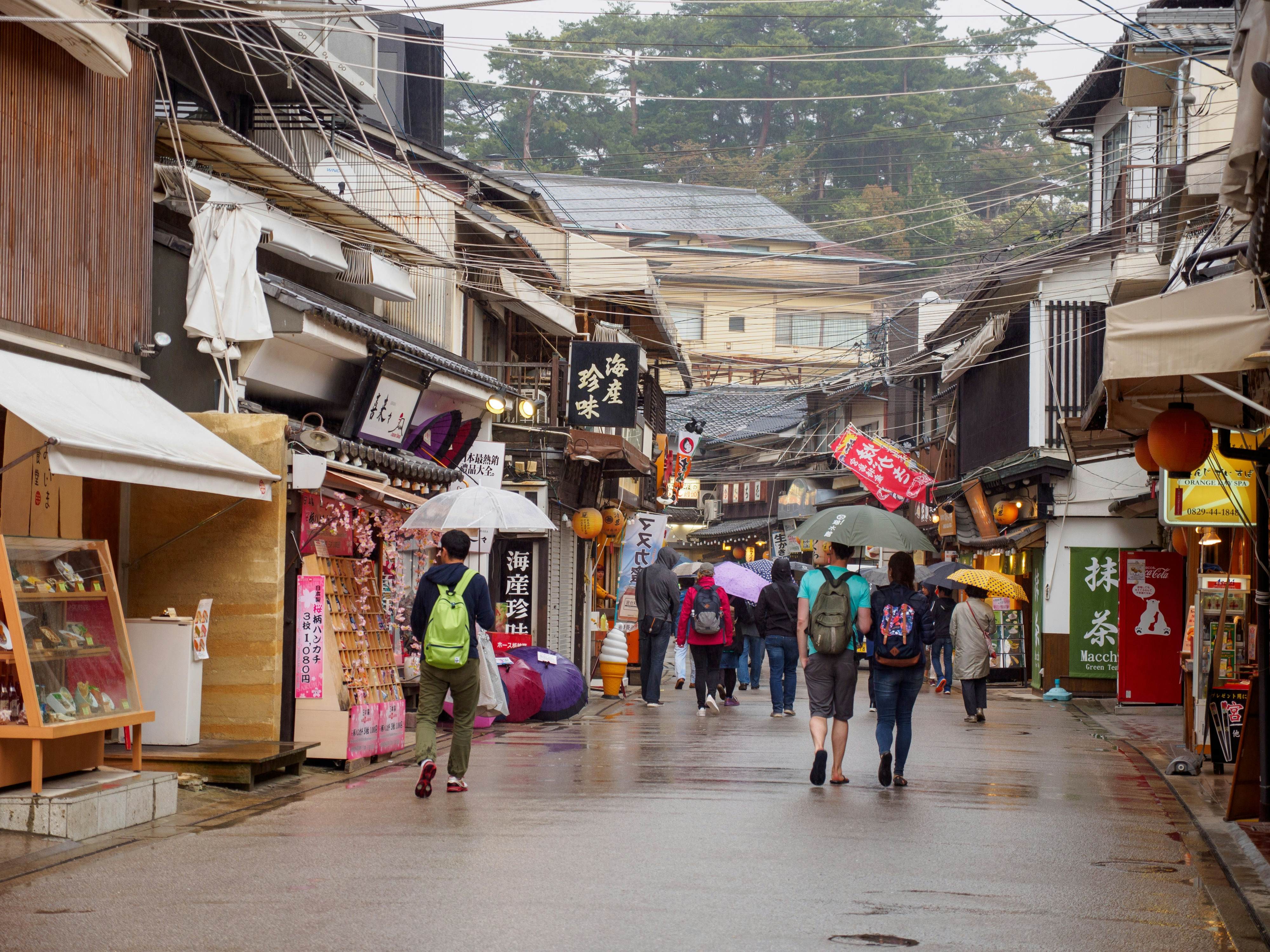 People under umbrellas in Japan, symbolizing the need to be prepared for rain and sun
People under umbrellas in Japan, symbolizing the need to be prepared for rain and sun
6.1 Essential Weather Gear
- Folding Umbrella: Protects against both sun and rain.
- Sunscreen: Essential during the summer months.
- Hat: Provides shade and protection from the sun.
- Cooling Wipes: Help to stay cool and refreshed in hot weather.
- Pocket Warmers: Provide warmth during the winter months.
- Water Bottle: Staying hydrated is crucial, especially during the summer.
6.2 Monitoring Weather Conditions
- Japan Meteorological Agency: Consult the Japan Meteorological Agency’s website for up-to-date weather forecasts and warnings in English.
6.3 Navigating Japan’s Diverse Climate
| Region | Season | Typical Weather Conditions | Packing Essentials |
|---|---|---|---|
| Tokyo | Spring | Mild temperatures, occasional rain | Light jacket, umbrella. |
| Kyoto | Summer | Hot and humid | Breathable clothing, sunscreen, hat. |
| Hokkaido | Winter | Cold and snowy | Heavy coat, gloves, scarf, waterproof boots. |
7. Carrying Cash and Understanding Payment Methods
While credit cards are becoming more widely accepted, it’s still essential to carry cash, especially when traveling to rural areas or patronizing smaller establishments.
- Rural Areas: Credit cards may not be accepted at country ryokan and smaller restaurants and shops.
- Cash is King: Assume you’ll need to pay cash in many situations.
- ATM Access: Stock up on cash when you’re in a town with an ATM.
- Payment Etiquette: Place your cash or card in the small tray at the register rather than handing it to the cashier.
7.1 Finding ATMs
- Convenience Stores: ATMs are commonly found in convenience stores like 7-Eleven and Lawson.
- Post Offices: Japan Post Bank ATMs are another reliable option.
- International Compatibility: Ensure the ATM accepts your card type (Visa, Mastercard, etc.).
7.2 Digital Payment Options
- Contactless Payments: Contactless payments like Apple Pay and Google Pay are becoming more common in urban areas.
- Mobile Payment Apps: Some Japanese mobile payment apps are available, but they may require a Japanese phone number and bank account.
7.3 Managing Your Finances in Japan
| Scenario | Preferred Payment Method | Rationale |
|---|---|---|
| Fine Dining | Credit Card | Offers convenience and potential rewards; service charges are often automatically added. |
| Street Food Stalls | Cash | Many smaller vendors may not accept card payments. |
| Public Transportation | IC Card (Suica or Pasmo) or Cash | Simplifies fare payment; IC cards can be preloaded with cash and used on trains and buses. |
8. Tipping Etiquette
Unlike many Western countries, Japan does not have a tipping culture. Attempting to tip may cause confusion or embarrassment.
- No Tipping: Tipping is not customary in Japan.
- Service Fees: Some bars and restaurants may charge a flat-rate service fee or automatically add a 10% service charge to the bill.
8.1 Understanding Service Charges
- Flat-Rate Service Fee: Typically around ¥300-¥500 per person.
- Automatic Service Charge: Usually 10% of the total bill, common in upscale establishments.
8.2 Expressing Gratitude
- Verbal Appreciation: Instead of tipping, express your gratitude verbally with phrases like “Arigato gozaimasu” (thank you very much).
- Small Gifts: In some situations, a small gift may be appropriate, but this is more common in personal relationships than in commercial transactions.
8.3 Navigating the No-Tipping Culture
| Service Provider | Tipping Expectation | Appropriate Alternatives |
|---|---|---|
| Restaurant Server | Not expected; attempting to tip may cause confusion. | Express sincere gratitude and compliment the service. |
| Taxi Driver | Not expected; offering a tip may be politely refused. | Ensure the fare is paid in full and thank the driver. |
| Hotel Staff | Not expected; tipping may be seen as unusual. | Write a positive review and express appreciation to the management. |
9. Queueing Culture
The Japanese are known for their orderly queueing. Forming neat lines is common in various situations, from check-out counters to train platforms.
- Neat Lines: Form neat lines in designated areas.
- Train Platforms: Line up in an orderly fashion while waiting for the train.
- Seating: After the train doors open, it’s everyone for themselves when it comes to scoring a seat.
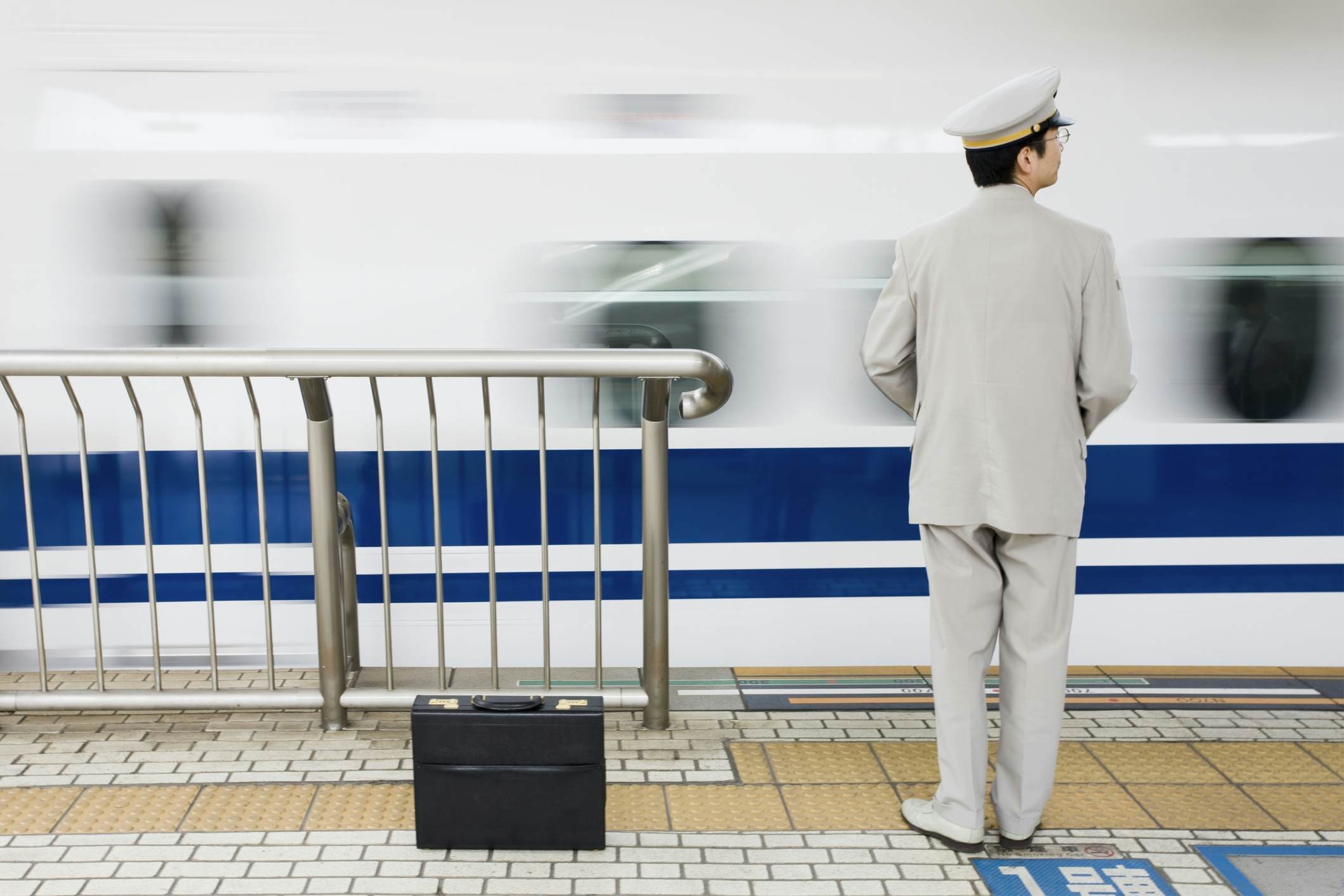 People queuing on a platform for a bullet train, highlighting the importance of queueing in Japan
People queuing on a platform for a bullet train, highlighting the importance of queueing in Japan
9.1 The Art of Patient Waiting
- Respectful Behavior: Avoid cutting in line or pushing ahead of others.
- Designated Areas: Look for designated queueing areas or follow the lead of other people.
9.2 Understanding Queueing Norms
| Situation | Queueing Protocol | Rationale |
|---|---|---|
| Train Platforms | Line up behind designated markings; allow passengers to disembark before boarding. | Ensures smooth and efficient boarding and disembarking. |
| Ticket Counters | Form a single line and wait patiently for your turn. | Maintains order and fairness in service provision. |
| Popular Restaurants | Join the queue outside the restaurant and wait to be seated. | Demonstrates respect for other patrons and the establishment. |
10. Escalator Etiquette
When riding escalators, stand to one side to allow others to walk past. The side you stand on depends on the region.
- Kanto (Tokyo) and Eastwards: Stand to the left.
- Kansai (Osaka) and Westwards: Stand to the right.
- Train Operator Recommendation: Train operators encourage passengers to stand on both sides of the escalator and refrain from walking altogether.
10.1 The Great Escalator Divide
- Nagoya: The dividing point between the Kanto and Kansai escalator customs is somewhere just west of Nagoya.
10.2 Promoting Safety on Escalators
- Hold the Handrail: Always hold the handrail for safety.
- Avoid Distractions: Pay attention to your surroundings and avoid using your phone while on the escalator.
10.3 Escalator Practices Across Japan
| Region | Standing Side | Walking Side | Common Etiquette |
|---|---|---|---|
| Tokyo | Left | Right | Stand to the left to allow others to walk on the right. |
| Osaka | Right | Left | Stand to the right to allow others to walk on the left. |
| Universal | N/A | N/A | Consider standing on either side and holding the handrail for safety. |
11. Last Train Awareness
City subways typically run until 1am at the latest. Missing the last train can be costly, as taxis can be expensive.
- Alternative Transportation: If you miss the last train, a taxi is the primary alternative.
- Taxi Fares: Taxi fares can be significantly higher than train fares, especially late at night.
11.1 Planning Your Evening Activities
- Check Train Schedules: Check the train schedules in advance to avoid missing the last train.
- Consider Accommodation Location: Choose accommodation that is conveniently located near train stations or other transportation options.
11.2 Navigating Late-Night Transportation
| Mode of Transport | Availability | Cost |
|---|---|---|
| Taxi | Available throughout the night. | More expensive than trains or buses; fares increase late at night. |
| Night Bus | Limited routes; may require advance booking. | Generally more affordable than taxis. |
| Capsule Hotels | An option for a place to stay if you miss the last train. | Can be cost-effective; provides basic accommodation. |
12. Avoiding Rush Hour in Tokyo
Tokyo’s morning commute is notorious for its crowded trains. If possible, avoid traveling during peak hours (7:30am to 9am) to avoid the worst of the congestion.
- Extreme Crowding: Millions of people squeeze into trains across the city during rush hour.
- Station Staff Assistance: Station staff may assist in packing passengers onto trains.
- Shinjuku Station: Shinjuku Station, the busiest in the world, sees an average of over 3.5 million commuters daily.
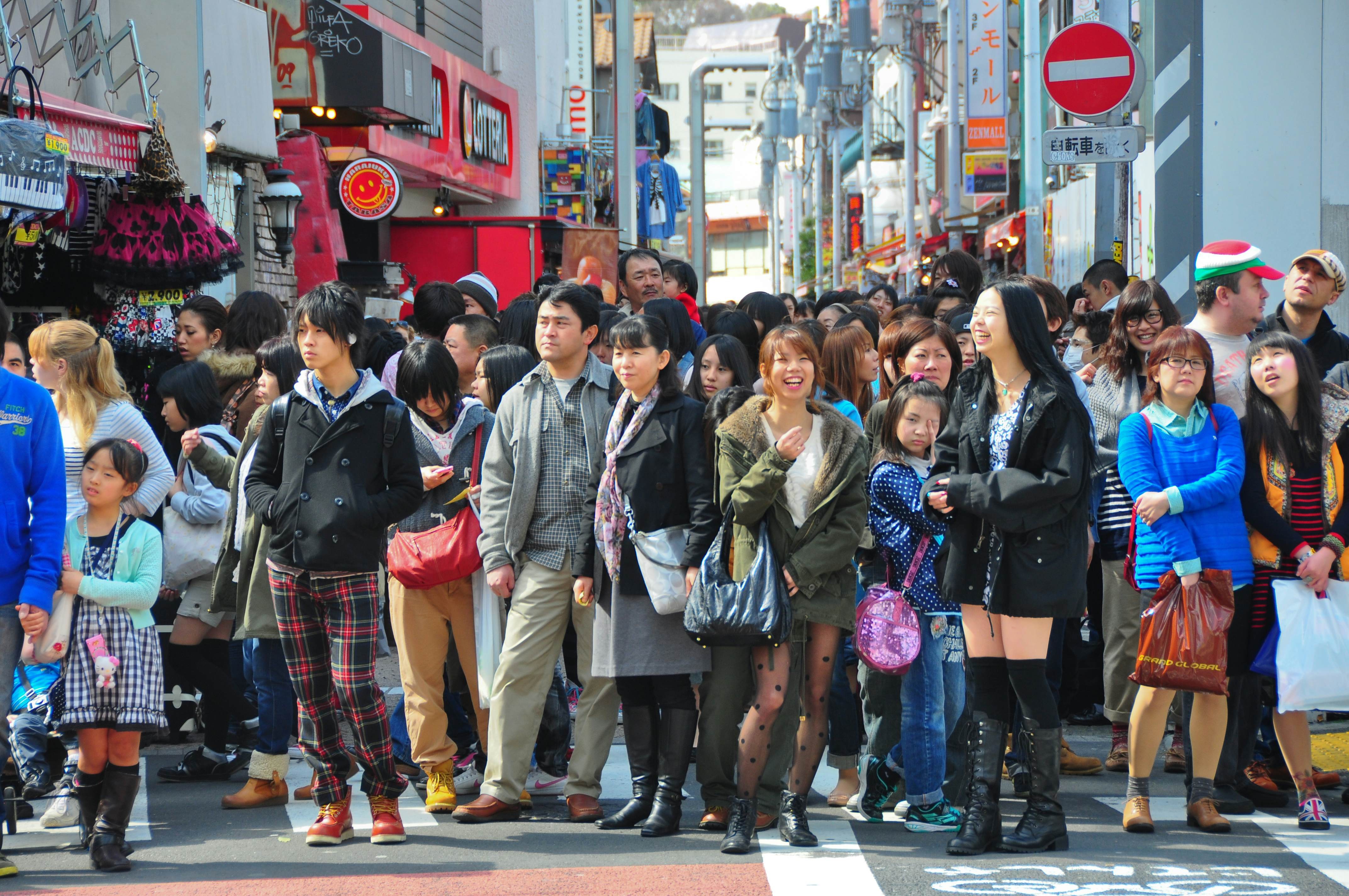 Crowded train station in Tokyo, emphasizing the challenges of rush hour
Crowded train station in Tokyo, emphasizing the challenges of rush hour
12.1 Alternative Travel Times
- Off-Peak Hours: Travel outside of the 7:30am to 9am window to avoid the worst of the crowds.
- Weekends and Holidays: Trains are typically less crowded on weekends and holidays.
12.2 Strategies for Surviving Rush Hour
- Plan Your Route: Plan your route in advance and allow extra time for potential delays.
- Stay Alert: Be aware of your surroundings and hold onto your belongings.
- Follow Instructions: Follow the instructions of station staff.
12.3 Peak Commute Survival Guide
| Strategy | Description | Benefits |
|---|---|---|
| Early Departure | Leave for your destination before the peak hours begin. | Avoids the worst of the crowds and ensures a more comfortable journey. |
| Route Optimization | Utilize apps like Google Maps or Citymapper to find less congested routes. | Reduces exposure to overcrowded trains and stations. |
| Patience and Awareness | Maintain composure and be mindful of personal space; follow instructions from station staff. | Ensures a smoother and safer commute experience. |
13. Public Eating Etiquette
Eating in public is generally frowned upon in Japan, especially while walking. However, there are exceptions.
- Exceptions: Eating is acceptable on the shinkansen (bullet train), at festivals or market streets with food vendors, on a picnic, and when eating ice cream.
- Beverages: It’s acceptable to take sips from a resealable beverage container.
13.1 Proper Dining Locations
- Restaurants: The most appropriate place to eat is in a restaurant or designated dining area.
- Food Courts: Food courts in department stores and shopping malls are also acceptable.
13.2 Understanding the Cultural Context
- Cleanliness: The prohibition against eating while walking is partly due to a concern for cleanliness.
- Respect: Eating in public is seen as less refined than sitting down to enjoy a meal.
13.3 Public Consumption: Dos and Don’ts
| Scenario | Etiquette | Rationale |
|---|---|---|
| Walking While Eating | Generally discouraged; avoid eating while moving. | Maintains public cleanliness and shows respect for social norms. |
| Eating on the Shinkansen | Acceptable; bento boxes are commonly consumed on board. | Part of the travel experience; convenient and socially acceptable. |
| Sipping Beverages | Permitted from resealable containers. | Allows for hydration without violating social norms. |
14. Earthquake and Tsunami Preparedness
Japan is located in a seismically active zone. While strong earthquakes are rare, minor tremors are common. It’s important to know what to do in the event of an earthquake or tsunami.
- Stay Calm: If you feel an earthquake, stay calm and take your cue from those around you.
- Seek Shelter: Head under a table or stand in a doorway.
- Tsunami Warnings: If you are near the coast and hear a tsunami warning, get to higher ground immediately.
14.1 Earthquake Safety Measures
- Drop, Cover, and Hold On: Drop to the ground, cover your head and neck, and hold onto something sturdy.
- Stay Away from Windows: Avoid standing near windows or other glass objects.
- Evacuation Routes: Familiarize yourself with evacuation routes in your hotel or accommodation.
14.2 Tsunami Preparedness
- Recognize the Signs: A strong earthquake near the coast can be a sign of a potential tsunami.
- Heed Warnings: Pay attention to tsunami warnings issued by local authorities.
- Move Inland and Uphill: If a tsunami warning is issued, move inland and uphill as quickly as possible.
14.3 Natural Disaster Preparedness Guide
| Disaster | Action | Rationale |
|---|---|---|
| Earthquake | Drop, cover, and hold on; stay away from windows; follow instructions from local authorities. | Minimizes risk of injury from falling debris and ensures safety during the tremor. |
| Tsunami | Move to higher ground immediately; heed tsunami warnings; stay informed via local media. | Reduces risk of drowning and ensures timely evacuation. |
| Typhoon | Stay indoors; avoid unnecessary travel; monitor weather updates; secure loose objects around your premises. | Minimizes exposure to hazardous conditions and protects against potential property damage. |
15. Basic Japanese Phrases
Learning a few basic Japanese phrases will enhance your interactions with locals and demonstrate your respect for their culture.
- Omori (large portion, often free at ramen stalls)
- Okawari (refill)
- Mochikaeri (takeaway)
- Tennai de (eat-in)
- Onegai shimasu (please). Follow up any of your orders or requests with this; for example, if you want tea, say, “O-cha onegai shimasu.”
- Sumimasen (excuse me)
- Arigato gozaimasu (thank you). Because it’s a bit of a mouthful, it’s tempting to shorten it to simply arigato. Think of it as the difference between “thank you” and “thanks” and go for the politer “arigato gozaimasu.”
- Toire (toilet; pronounced “to-ee-rey”)
15.1 Essential Phrases for Dining
- “Gochisosama deshita” (Thank you for the meal)
- “Oishii desu” (It’s delicious)
15.2 Phrases for Getting Around
- “Eki wa doko desu ka?” (Where is the station?)
- “Kore wa nan desu ka?” (What is this?)
15.3 Key Japanese Phrases for Travelers
| Phrase | Romanization | Meaning | Usage Scenario |
|---|---|---|---|
| こんにちは | Konnichiwa | Hello | Greeting during the daytime. |
| ありがとう | Arigato | Thank you | Expressing gratitude for a service or favor. |
| すみません | Sumimasen | Excuse me; I’m sorry | Apologizing or getting someone’s attention politely. |
| おねがいします | Onegaishimasu | Please | Requesting assistance or placing an order. |
| わかりません | Wakarimasen | I don’t understand | Indicating a lack of comprehension. |
Conclusion: Your Unforgettable Japan Adventure Awaits
With these tips in mind, you’re well-prepared to embark on an unforgettable journey to Japan. Remember to embrace the local customs, be respectful of the culture, and enjoy the incredible experiences that await you. Japan offers a unique blend of tradition and modernity, ensuring a travel adventure unlike any other.
Ready to Plan Your Dream Trip to Japan?
Let TRAVELS.EDU.VN take the stress out of planning your Japan adventure. Our expert travel consultants can help you create a personalized itinerary that caters to your interests and budget. We offer a range of services, including:
- Customized Itineraries: We’ll create a tailor-made itinerary based on your preferences and interests.
- Accommodation Bookings: We’ll secure the best hotels and ryokan to suit your needs.
- Transportation Arrangements: We’ll handle all your transportation needs, including flights, trains, and buses.
- Guided Tours: Our knowledgeable guides will provide you with insights into Japan’s culture and history.
- 24/7 Support: We’re available 24/7 to assist you with any questions or concerns during your trip.
Contact TRAVELS.EDU.VN today to start planning your dream trip to Japan. Visit our website at TRAVELS.EDU.VN or call us at +1 (707) 257-5400. You can also visit our office at 123 Main St, Napa, CA 94559, United States. Let us help you create memories that will last a lifetime!
Frequently Asked Questions (FAQ) About Traveling to Japan
-
What is the best time to visit Japan? The best time to visit Japan is during the spring (March-May) for cherry blossoms or autumn (September-November) for colorful foliage.
-
Do I need a visa to travel to Japan? Visa requirements depend on your nationality. Check with the Japanese embassy or consulate in your country for the most up-to-date information.
-
What currency is used in Japan? The currency used in Japan is the Japanese Yen (JPY).
-
Is English widely spoken in Japan? English is spoken in major cities and tourist areas, but it’s helpful to learn some basic Japanese phrases.
-
What is the voltage and plug type in Japan? Japan uses 100V and Type A and B plugs. You may need to bring an adapter and converter.
-
How do I get around in Japan? Japan has an excellent public transportation system, including trains, subways, and buses.
-
What should I pack for my trip to Japan? Pack comfortable walking shoes, versatile clothing, a data-heavy SIM card, and any necessary adapters and converters.
-
What is the tipping etiquette in Japan? Tipping is not customary in Japan.
-
What are some common Japanese customs I should be aware of? Be aware of customs such as removing your shoes indoors, queueing in an orderly fashion, and avoiding eating while walking.
-
What should I do in case of an earthquake? Stay calm, seek shelter under a table or in a doorway, and follow instructions from local authorities.
Contact travels.edu.vn on Whatsapp today for professional consultation and to book your unforgettable trip to Japan.